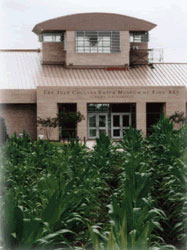Cullars Rotation Makes National Register of Historical Places

The Cullars Rotation experiment (circa 1911), located on the Auburn University campus, was placed on the National Register of Historical Places in April 2003. It joins the nearby Old Rotation experiment (circa 1896) as one of only four field crop research sites in the United States to receive this honor. (The other two sites are the Morrow Plots at the University of Illinois and the Sanborn Field at the University of Missouri.)
Charles Mitchell, professor of agronomy and soils and project leader for the Cullars Rotation, notes that it is the oldest soil fertility study in the South and one of America's oldest, continuous field crop experiments.
The Cullars Rotation is located on property known as the Alvis Field, on the corner of South College Street and Woodfield Drive in Auburn. The experiment is directly behind the new Jule Collins Smith Museum of Art and will be a historical, cultural and agricultural part of the site.
According to Mitchell, John P. Alvis and his brother-in-law, J.A. Cullars, owned and farmed this property in the late 1800s. Cullars allowed Professor George F. Atkinson and others to conduct numerous early cotton fertility experiments on this property, work which led to the discovery that "cotton rust" was caused by a deficiency of potassium.
In 1911, the Alabama Legislature appropriated to the Alabama Agricultural Experiment Station (AAES) a sum of money to conduct on-farm research throughout the state. There were no outlying research stations at that time, so research had to be on farmers fields. AAES Bulletin 219 published in 1923 summarized 226 experiments on farmers' fields throughout Alabama. An extensive cotton, corn and legume fertility test begun in 1911 on the Cullars-Alvis farm in Auburn is the only one of these experiments that has been continued.
Unlike the nearby "Old Rotation" experiment, which was begun by Professor J.F. Duggar, records do not credit any single researcher with designing the Cullars Rotation experiment. Names of professors and researchers who have been associated with the Cullars Rotation include J.F.Duggar, E.F. Cauthen, J.T. Williamson, M.J. Funchess, D.G. Sturkie, E.M. Evans, L.E. Ensminger, J.T. Touchton and C.C. Mitchell.
In 1938, Alvis Field was sold to Alabama Polytechnic Institute (now Auburn University) by Bessie Alvis Emerick and Lillian Alvis Miller, daughters and heirs of John P. Alvis. In 2000, construction of the Jule Collins Smith Museum of Art occupied most of the Alvis Field, but the Cullars Rotation, with a 40-foot border, is preserved for on-going research and demonstration on sustainable crop production on soils of the southern U.S.
Once the museum opens, visitors will be able to stroll through the museum gardens and visit an on-going research project that demonstrates the effect of different fertilizer nutrients on a crop rotation that includes cotton, corn, soybeans, wheat and clover. The entire Cullars Rotation experiment occupies almost four acres of the old Alvis Field.
The Web site for the Cullars Rotation is http://www.ag.auburn.edu/dept/ay/cullars.htm.
